Unit 1 Electrostatics Chapter 2 Electric Field Long Questions and Answers
Question 1. Two charges, +q and -q are separated by a distance d. At which points will the resultant electric field intensity be directed parallel to the line joining the charges?
Answer:
Given
Two charges, +q and -q are separated by a distance d.
The resultant electric field intensity at all points on the plane perpendicular to the line joining the two charges and passing through its mid-point is directed parallel to the line joining the charges.
In, P is a point on this plane corresponding to the two charges at A and B. AP = BP = r (say).
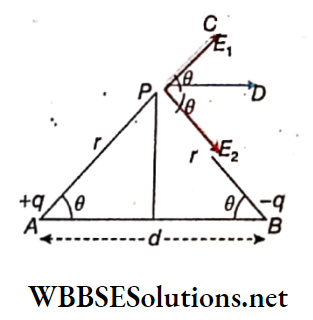
Intensity at P due to the charge +q,
⇒ \(E_1=\frac{q}{r^2} ; \text { along } \overrightarrow{P C}\)
Intensity at P due to the charge -q,
⇒ \(E_2=\frac{q}{r^2} ; \text { along } \overrightarrow{P B}\)
Therefore, E1 = E2
The resultant of these two intensities will be along \(\vec{PD}\) , which is the bisector of the angle ZCPB.
∴ ∠CPD = ∠DPB = ∠PBA = 6 (say)
∴ PD is parallel to AB.
Question 2. Two-point charges are separated by a certain distance. Electric field Intensity is zero at a point In between the two charges. What can we conclude about the charges?
Answer:
Two-point charges are separated by a certain distance. Electric field Intensity is zero at a point In between the two charges.
If the intensity of the electric field is zero at a point in between two charges, we conclude that the two charges are of the same nature.
If the charges are not of the same nature, the electric field due to the two charges will act in the same direction. Thus the resultant field will not be zero
Question 3. A ring of radius R carries a uniformly distributed charge + Q. A point charge -q is placed on the axis of the ring at a distance 2R from its center and then released. Will the charge -q execute a simple harmonic motion along the axis of the ring?
Answer:
A ring of radius R carries a uniformly distributed charge + Q. A point charge -q is placed on the axis of the ring at a distance 2R from its center and then released.
In this case, it can be shown that the force on the point charge -q is inversely proportional to the square of its distance from the center of the ring.
This is not the characteristic of a simple harmonic motion. So the particle will not execute a simple harmonic motion,
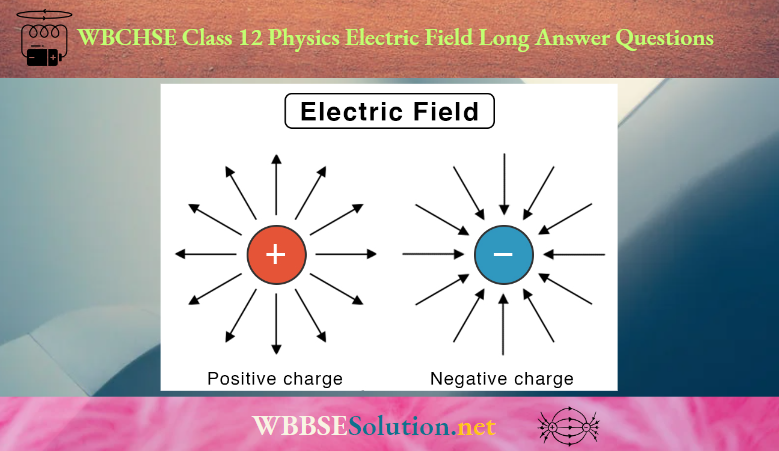
Question 4. Two small balls have equal positive charges Q (coulomb). They are suspended by two long strings of equal length L (meter) from a hook fixed to a stand. The whole setup is taken to a satellite In space where there Is no gravity (state of weightlessness). Calculate the angle between the two strings and the tension in each string in Newton.
Answer:
Two small balls have equal positive charges Q (coulomb). They are suspended by two long strings of equal length L (meter) from a hook fixed to a stand. The whole setup is taken to a satellite In space where there Is no gravity (state of weightlessness).
As the two balls are weightless, no downward force acts on them. The two strings will be horizontal due to the electrostatic repulsive force between the balls, i.e., the angle between the strings will be 180°.
Tension in each string = \(\frac{1}{4 \pi \epsilon_0}: \frac{Q^2}{(2 L)^2}=\frac{Q^2}{16 \pi \epsilon_0 L^2} \mathrm{~N}\)
Question 5. A charge q Is placed at the mid-point of the line Joining two equal charges Q. For what value of q will the system of the three charges be In equilibrium?
Answer:
A charge q Is placed at the mid-point of the line Joining two equal charges Q.
Two equal charges Q are placed at A and B
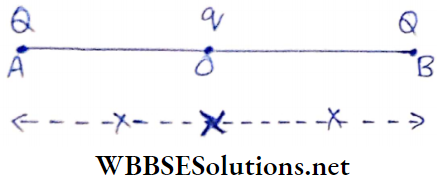
Charge q is placed at O.
Here, OA = OB = x (say)
Force on the charge q placed at O,
⇒ \(F_1=\frac{1}{4 \pi \epsilon_0}\left[\frac{Q q}{x^2}-\frac{Q q}{x^2}\right]=0\)
Force on the charge Q placed at A,
⇒ \(F_2=\frac{1}{4 \pi \epsilon_0}\left[\frac{Q q}{x^2}+\frac{Q^2}{4 x^2}\right]\)
If the whole system is in equilibrium,
F2 = F1 = 0
∴ \(\frac{1}{4 \pi \epsilon_0}\left[\frac{Q q}{x^2}+\frac{Q^2}{4 x^2}\right]=0\)
or, \(\frac{Q q}{x^2}+\frac{Q^2}{4 x^2}=0 \quad\)
or, \(\frac{Q q}{x^2}=-\frac{Q^2}{4 x^2} \quad\)
or, \(q=-\frac{Q}{4}\)
Question 6. Two equal negative charges -q are fixed at points (0, a) and (0, -a) on the Y-axis. A positive charge Q is released from rest at the point (2a, 0) on the X-axis. Will the charge Q execute simple harmonic motion?
Answer:
Two equal negative charges -q are fixed at points (0, a) and (0, -a) on the Y-axis. A positive charge Q is released from rest at the point (2a, 0) on the X-axis.
Charge Q will move to and fro along ROR’. Point 0 is the equilibrium position of the charge Q. Now we shall have to whether the force acting on the charge Q is proportional to the distance of Q from O.
Let the charge Q be the point P(x,0) at any instant.
At that time each of the charges -q exerts force F’ on Q
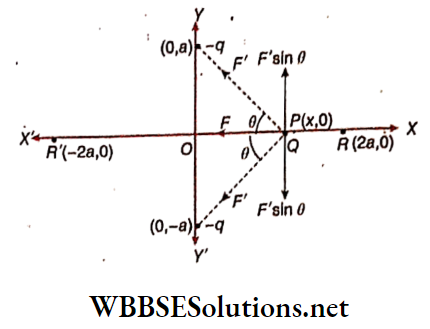
Therefore, from Coulomb’s law we get,
⇒ \(F^{\prime} \propto-\frac{1}{a^2+x^2}\)
Now, \(F=2 F^{\prime} \cos \theta=2 F^{\prime} \times \frac{x}{\sqrt{a^2+x^2}}\)
or, \(F^{\prime}=\frac{\sqrt{a^2+x^2}}{2 x} F\)
∴ \(\frac{F \sqrt{a^2+x^2}}{2 x} \propto-\frac{1}{a^2+x^2}\)
or, \(F \propto-\frac{x}{\left(a^2+x^2\right)^{3 / 2}}\)
The condition for a simple harmonic motion, F ∝ -x, does not match the above expression. So, the charge Q will not exe- ( cute a simple harmonic motion.
Question 7. A point charge q moves from point P to point S along the path PQRS in a uniform electric field E pointing parallel to the positive X-axis. The coordinates of P, Q, R, and S are (a, b, 0), (2a, 0,0), (a, -b, 0), and (0,0,0) respectively. Determine the work done by the field In the above process.
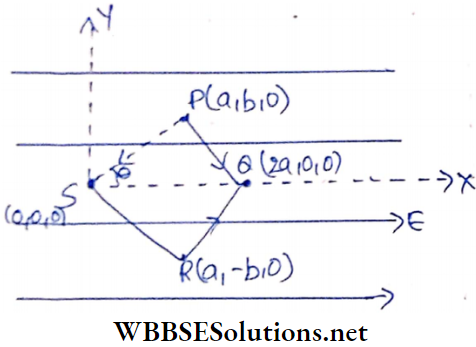
Answer:
A point charge q moves from point P to point S along the path PQRS in a uniform electric field E pointing parallel to the positive X-axis. The coordinates of P, Q, R, and S are (a, b, 0), (2a, 0,0), (a, -b, 0), and (0,0,0) respectively.
Displacement of charge q is PS = \(\sqrt{a^2+b^2}\)
Component of intensity along PS = -Ecosθ = \(-E \cdot \frac{a}{\sqrt{a^2+b^2}}\)
The force against which the external agent does work during the displacement PS of the charge q is,
⇒ \(F=q E \times \frac{a}{\sqrt{a^2+b^2}}\)
Work done by the external agent
⇒ \(F \times P S=q E \cdot \frac{a}{\sqrt{a^2+b^2}} \cdot \sqrt{a^2+b^2}\)
= qEa
Work done by the electric field = -qEa
Question 8. The presence of matter alters the net force acting between two charges. Explain.
Answer:
The presence of matter alters the net force acting between two charges.
According to Coulomb’s law, the effective force between two charges q1 and q2 placed in air or vacuum at a distance r from each other,
⇒ \(F_1=\frac{q_1 q_2}{r^2}\)
Now, let the charges be placed in a medium of permittivity k.
The effective force between the two charges now is,
⇒ \(F_2=\frac{q_1 q_2}{k r^2}\)
Clearly, F2 < F1 , since k > 1 . So the effective force between two charges in the presence of another matter is less. The charges induced in this medium are responsible for this decrease of force
Question 9. What is the difference between the electrical effects due to a point charge at rest and that in motion?
Answer:
The difference between the electrical effects due to a point charge at rest and that in motion
A point charge at rest produces an electric field surrounding it If the point charge is in motion, it constitutes an electric current and a magnetic field is produced by the current The resulting field is then an electromagnetic field.
Question 10. What is the significance of Gauss’ theorem? Does it applicable to any fields other than electric fields?
Answer:
The significance of Gauss’ theorem
If the electric field intensities at all points of a closed surface are known, then with the help of Gauss’ theorem, the amount of charge responsible for creating the field can be found out Again if the charge enclosed by a surface is known, intensities at various points on it can be calculated.
This theorem is also applicable to conservative fields, like magnetic field and gravitational field
Question 11. Can a field line start from a charged conductor and end on it? Answer with reason.
Answer:
If a line of force starts from a charged conductor and terminates on it, one part of the conductor should be positively charged and the other part negatively charged.
But die external surface of a charged conductor is always an equipotential surface. So it is not possible for a conductor to be charged positively in one part and negatively in another part. Thus a field line cannot start from a conductor and end on the same.
Question 12. Two lines of force in an electric field never intersect each other. Why?
Answer:
Two lines of force in an electric field never intersect each other.
Two lines of force can never intersect each other, because if they do so, then at the point of intersection two tangents can be drawn in two different directions. It means that the electric intensity has two directions at a single point, which is not possible.
Question 13. An electric dipole is placed in a uniform electric field so that its axis lies along the electric field. Does any force or torque act on the dipole?
Answer:
An electric dipole is placed in a uniform electric field so that its axis lies along the electric field.
When an electric dipole is placed along a uniform electric field, a force acting on +q of the dipole is qE along the direction of \(\vec{E}\), and force acting on -q is qE in the opposite direction of \(\vec{E}\).
So, the resultant force on the dipole = q\(\vec{E}\) – q\(\vec{E}\) = 0
Since the two equal forces act along the same line, they cannot produce a torque.
So in this case, neither a force nor a torque acts on the dipole.
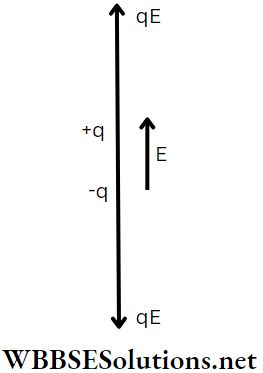
Question 14. An electric dipole is placed in a uniform electric field with its axis inclined at a certain angle with the field. Does any force or torque act on the dipole?
Answer:
An electric dipole is placed in a uniform electric field with its axis inclined at a certain angle with the field.
When an electric dipole is inclined at a certain angle with the direction of the field, force acting on +q of the dipole is qE along the direction of \(\vec{E}\), and force acting on-q is qE in the opposite direction of \(\vec{E}\). So a torque acts on the dipole which tends to bring the dipole along the direction of the field. r In this case, the net force acting on the dipole
= q\(\vec{E}\) – q\(\vec{E}\)
= 0
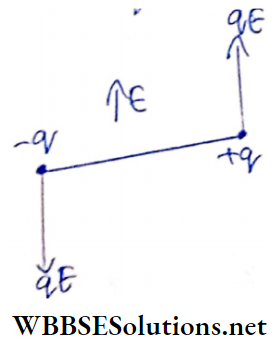
Therefore, a torque acts on the dipole but no resultant force acts on it
Question 15. What should the angle of the field line with them normal to its surface so that the flux linked with the surface becomes maximum?
Answer:
Let the intensity of the electric field E make an angle 0 with the normal to a surface element ds Flux linked with the surface = E cosθ ds Now, Ecosθds will be maximum if cosθ = 1 i.e., θ = 0º
So, if the field line makes an angle of 0º with the normal to the surface, the flux linked with the surface becomes maximum.
Question 16. If an electric dipole is placed in a nonuniform electric field, does any torque or force add to the dipole?
Answer:
If an electric dipole Is placed In a non-uniform electronic field, two non-equal, non-parallel forces act at the two ends of the dipole. These forces acting on the dipole produce both rotational and translational motions.
So In this case, a torque and a force both act on the dipole,
Question 17. Eight electric dipoles each with charge e are placed inside a culm. What should be the total electric flux linked with the cube?
Answer:
Eight electric dipoles each with charge e are placed inside a culm.
An electric dipole consists of two equal but opposite charges. So here the net charge enclosed is zero. Therefore, the total flux linked with the cube is zero.
Question 18. A cylinder is lying with an axis parallel to a uniform electric field \(\vec{E}\). What Is the total flux through the cylinder with cross-section S and length L?
Answer:
A cylinder is lying with an axis parallel to a uniform electric field \(\vec{E}\).
Electric field \(\vec{E}\) and the axis of the cylinder are in the same direction. So, the electric flux = EScosθ = ES
Question 19. An electric dipole is situated In a uniform electric field \(\vec{E}\) such that Its moment \(\vec{E}\) is aligned in the direction of the field. Is the equilibrium of the dipole stable or unstable? If \(\vec{E}\) and \(\vec{E}\) are In opposite directions, what will be the nature of the equilibrium?
Answer:
An electric dipole is situated In a uniform electric field \(\vec{E}\) such that Its moment \(\vec{E}\) is aligned in the direction of the field.
When the electric dipole moment \(\vec{E}\) is aligned in the direction of the field \(\vec{E}\), the dipole is in stable equilibrium
Because if the dipole is deflected through an angle θ, the torque pEsinθ acting on it brings it back along the field. When p and E are in opposite directions (0 = 180°), the torque acting on the dipole is zero and the dipole is again in equilibrium.
But this equilibrium is unstable because if the dipole is deflected from its present position, the torques acting on it now will rotate the dipole to set it in the direction of the field.
Question 20. The electric field due to a small dipole of length 2l at a distance r(r >> l) from the center of the dipole on the axial line is E. What is the distance of the point on the perpendicular bisector of the dipole from its center at which the electric field intensity is E?
Answer:
The electric field due to a small dipole of length 2l at a distance r(r >> l) from the center of the dipole on the axial line is E.
For a small dipole, the electric field intensity at a distance r from the center of the dipole on the axial line,
⇒ \(B=\frac{2 p}{4 \pi \epsilon_0 r^3}\)
Let the electric field intensity at a distance r’ from the center of the dipole on the perpendicular bisector of the dipole be E’.
∴ \(B^{\prime}=\frac{p}{4 \pi \epsilon_0\left(r^{\prime}\right)^3}\)
Thus, \(\frac{2 p}{4 \pi \epsilon_0 r^3}=\frac{p}{4 \pi \epsilon_0\left(r^{\prime}\right)^3}\) [∵ E = E’]
or, \(r^{\prime}=\frac{r}{\sqrt[3]{2}}\)
Hence, required distance = [ latex]\frac{r}{\sqrt{3}{2}}[/latex]
Question 21. A particle of mass m Is attached to one end of a massless rigid non-conducting rod of length l. Another particle of the same mass Is attached to the other end of the rod. Two particles carry charges +q and -q. This arrangement is held in the region of uniform electric field E such that the rod makes an angle 0 ( < 5°) with the field direction. Find an expression for the minimum time that Is needed for the rod to become parallel to the field after it is set free.
Answer:
A particle of mass m Is attached to one end of a massless rigid non-conducting rod of length l. Another particle of the same mass Is attached to the other end of the rod. Two particles carry charges +q and -q. This arrangement is held in the region of uniform electric field E such that the rod makes an angle 0 ( < 5°) with the field direction.
As the rod has two charges of equal magnitude (but opposite), the torque acting on the rod,
⇒ \(\tau\) = qE x lsinθ
or, \(\tau\) = qEl0 [∵ θ < 5°]
We know, \(\tau\) = Ia [where I = moment of inertia and α = angular acceleration]
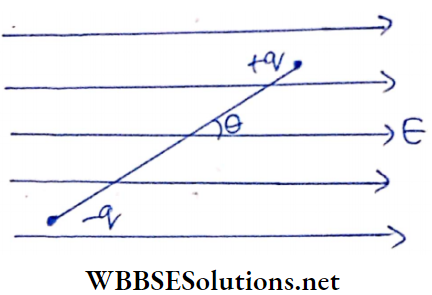
Hence, \(I \alpha=q E l \theta \quad \text { or, } \alpha=\frac{q E l \theta}{I}\)
∴ Time period, \(T=2 \pi \sqrt{\frac{\text { angular displacement }}{\text { angular acceleration }}}=2 \pi \sqrt{\frac{I}{q E l}}\)
Now, moment of inertia of the dipole,
⇒ \(I=\left[\left(\frac{l}{2}\right)^2+\left(\frac{l}{2}\right)^2\right] m=\frac{1}{2} m l^2\)
∴ \(T=2 \pi \sqrt{\frac{m l^2}{2 q E l}}=2 \pi \sqrt{\frac{m l}{2 q E}}\)
∴ Required time, \(t=\frac{1}{4} \times \text { time period }=\frac{T}{4}=\frac{\pi}{2} \sqrt{\frac{m l}{2 q E}}\)
Question 22. A uniform non-conducting rod of mass m and length l has linear charge densities + A and -A on its two halves. It is hinged at its midpoint so that it can rotate freely about the mid-point in a uniform electric field E parallel to the A-axis. The rod is rotated by a small angle of 8(< 4°) and released. Calculate the time period of small oscillations of the rod.
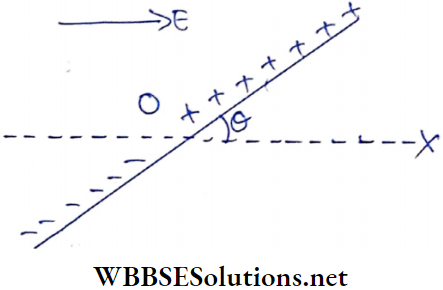
Answer:
A uniform non-conducting rod of mass m and length l has linear charge densities + A and -A on its two halves. It is hinged at its midpoint so that it can rotate freely about the mid-point in a uniform electric field E parallel to the A-axis. The rod is rotated by a small angle of 8(< 4°) and released
The torque due to the electrostatic force on a length dx of the rod at point A (about point O),
⇒ \(d \tau_1=x\left(d F_1\right) \sin \theta=x \lambda d x E \sin \theta\)
Similarly, torque due to the electrostatic force on a length dx of the rod at point B (about point O),
⇒ \(d \tau_2=x\left(d F_2\right) \sin \theta=x \lambda d x E \sin \theta\)
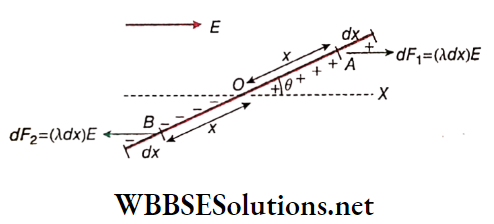
∴ Net torque on the rod,
⇒ \(\tau=\int_0^{\frac{l}{2}} d \tau_1+\int_0^{\frac{l}{2}} d \tau_2\)
⇒ \(2 \int_0^{\frac{l}{2}} E \lambda d x(x \sin \theta)\) [∵ \(d \tau_1=d \tau_2\)]
⇒ \(2 E \lambda \theta \int_0^{\frac{l}{2}} x d x\) [∵ 6 is small, sinθ == 0]
∴ \(\tau=\frac{E \lambda l^2}{4} \theta\)……(1)
In this case moment of inertia of rod,
⇒ \(I=\frac{m l^2}{12}\)
∴ \(\tau=I \alpha=\frac{m l^2}{12} \alpha\)……(2)
From equations (I) and (2) we get,
⇒ \(\frac{m l^2}{12} \alpha=\frac{E \lambda l^2 \theta}{4} \quad\)
or, \(\alpha=\frac{3 E \lambda}{m} \theta\)
∴ The time period of oscillations of the rod,
⇒ \(T=2 \pi \sqrt{\frac{\theta}{\alpha}}=2 \pi \sqrt{\frac{m}{3 E \lambda}}\)
Question 23. Two infinitely large sheets having charge densities σ1 and σ2 respectively (σ1 > σ2) are placed near each other separated by distance d. A charge q is placed in between two plates such that there is no effect on charge distribution on plates. Now this charge is moved at an angle of 45° with the horizontal towards plate A having charge density σ2 by distance a (a < d). Find the work done by the electric field in the process.
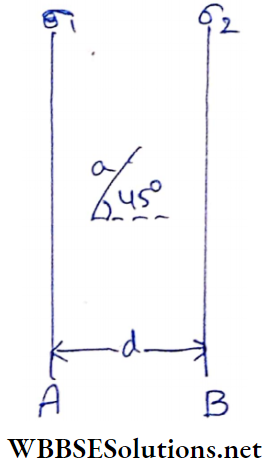
Answer:
Two infinitely large sheets having charge densities σ1 and σ2 respectively (σ1 > σ2) are placed near each other separated by distance d. A charge q is placed in between two plates such that there is no effect on charge distribution on plates. Now this charge is moved at an angle of 45° with the horizontal towards plate A having charge density σ2 by distance a (a < d).
An electric field near a large sheet is given by,
⇒ \(E=\frac{\sigma}{2 \epsilon_0}\)
In between the plates, the two fields are in opposite directions
Hence, \(E_{\text {net }}=\frac{\sigma_1-\sigma_2}{2 \epsilon_0}=E_0(\text { say })\)
Now work is done,
W = Facosθ = qE0acos45°
⇒ \(q\left(\frac{\sigma_1-\sigma_2}{2 \epsilon_0}\right)\left(\frac{a}{\sqrt{2}}\right)=\frac{\left(\sigma_1-\sigma_2\right)}{2 \sqrt{2} \epsilon_0} q a\)
Question 24. A small charge is placed at a point in a static electric field. Will the charge move along the electric line of force passing through that point?
Answer:
A small charge is placed at a point in a static electric field.
If the electric line of force is a straight line, then the charge will move along the electric line of force. If the line of force is curved, then the charge will not move along that line of force because the electric line of force indicates the direction of acceleration of the charge, not the direction of the velocity of the charge.
Therefore, If a charge Is placed In an electric field, the locus of the charge does not overlap with the electric line of force,
Question 25. Two point charges e1 and e2 are separated by a distance d. What can be concluded from this?
Answer:
Two point charges e1 and e2 are separated by a distance d.
In the first case, let the distance of point P from e1 is x and from e2 is (d-x)
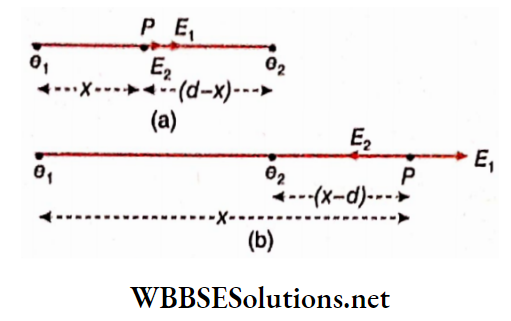
Electric field at P due to \(e_1, E_1=\frac{e_1}{x^2}\)
Electric field at P due to \(e_2, E_2=\frac{e_2}{(d-x)^2}\)
If e1 and e2 are oppositely charged, then the directions of E1 and E2 at point P will be the same, and their resultant field,
⇒ \(E=\frac{e_1}{x^2}+\frac{e_2}{(d-x)^2}\)
In this case, E will never be zero.
If e1 and e2 are oppositely charged, then the directions of E1 and E2 at point P will be the same and their resultant field, from e2 is (x-d)
In this case, \(E_1=\frac{e_1}{x^2} \text { and } E_2=\frac{e_2}{(x-d)^2}\)
If e1 and e2 are oppositely charged, E1 and E2 will act in opposite directions.
∴ Resultant electric field, \(E=\frac{e_2}{(x-d)^2}-\frac{e_1}{x^2}\)
In this case, if e1 = e2 then E2 will always be unequal. E will never be zero.
Therefore, if the electric field is not zero at any point, then e1 and e2 are equal and opposite in nature, i.e., e1 = -e2.
Question 26. The force between two charges depends on the presence of the material between them – explain.
Answer:
The force between two charges depends on the presence of the material between them
From Coulomb’s law in a vacuum or air medium, the force acting between two charges q1 and q2 separated by a distance r,
⇒ \(F_1=\frac{q_1 q_2}{4 \pi \epsilon_0 r^2}\)
Now If a material of permittivity c Is placed in the space between the two charges then the effective force acting between the two charges,
⇒ \(F=\frac{q(Q-q)}{4 \pi \epsilon_0 r^2}\)
So, F1 ≠ P2
Therefore, the force acting between two charges changes in the presence of a material medium between them.
Question 27. Charge Q Is distributed between two particles. What should be the value of charges on the particles so that the repulsive force acting between them Is maximum?
Answer:
Charge Q Is distributed between two particles.
Let the charge on one particle be q a°d that on the other particle is (Q-q) If the distance between them is r then force acting between them,
⇒\(F=\frac{q(Q-q)}{4 \pi \epsilon_0 r^2}\)
The value of F is the maximum for a given value of q, for that value of q,
⇒ \(\frac{d F}{d q}=0\)
∴ \(\frac{d F}{d q}=\frac{1}{4 \pi \epsilon_0 r^2} \cdot \frac{d}{d q}\left(Q q-q^2\right)=0\)
or, \(\frac{1}{4 \pi \epsilon_0 r^2} \cdot(Q-2 q)=0 \quad \text { or, } Q-2 q=0\)
∴ q = \(\frac{Q}{2}\)
Question 28. A tree electron and a free proton are placed In a uniform electric field. Compare their acceleration and the force acting on them. [Rest mass of electron = 9.1 x10-31kg and rest mass of proton = 1.67 X 10-27 kg]
Answer:
A tree electron and a free proton are placed In a uniform electric field.
If the intensity of the electric field is E, then the force acting on the electron,
Fe = eE [where, e = charge of electron]
Since the charge of a proton is the same as an electron, then the force acting on the proton,
⇒ \(F_p=e E \quad \text { or, } \frac{F_e}{F_p}=1\)
Let fe and fp be the acceleration of electron and proton respectively, then,
⇒ \(\frac{f_e}{f_p}=\frac{\frac{e E}{m_e}}{\frac{e E}{m_p}}\)
= \(\frac{m_p}{m_e}\)
= \(\frac{1.67 \times 10^{-27}}{9.1 \times 10^{-31}}\)
= 1835.2 [me = mass of electron, mp = mass of proton]
Question 29. Why electric fields just outside the surface of a conductor is perpendicular to the surface?
Answer:
Charge in a conductor resides on the outer surface. If a unit positive charge is placed just outside the surface to the conductor then it is attracted or repulsed perpendicular to the surface, that is the electric field at that position is also perpendicular to the surface.
Question 30. In the case of the field outside a uniformly charged sphere, the charge can be assumed to be concentrated at the center of the sphere. How can you prove it?
Answer:
Let a sphere of radius r be changed uniformly with charge q. A point P is taken outside the sphere at a distance x(x > r) from the center of the sphere
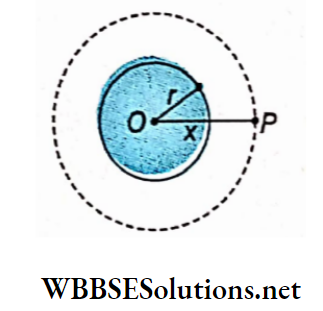
To evaluate the electric field intensity at point P, let us imagine a spherical Gaussian surface concentric to the original conducting sphere.
If E is the intensity of the electric field at a point on the spherical Gaussian surface of radius x, then;
total electric flux = E 4πr²
According to the Gauss’ theorem (in SI)
total electric flux = \(\frac{q}{\epsilon_0}\)
∴ \(E \cdot 4 \pi x^2=\frac{q}{\epsilon_0} \quad\)
or, \(E=\frac{1}{4 \pi \epsilon_0} \cdot \frac{q}{x^2}\)
again, if a charge q is imagined at the center of a sphere of radius x , then from Coulomb’s law (in SI)
⇒ \(E=\frac{1}{4 \pi \epsilon_0} \cdot \frac{q}{x^2}\)
Therefore, in the case of the electric field outside a uniformly charged sphere, the charge can be assumed to be concentrated at the centre of the sphere.
Question 31. How the force acting between two charges will change if the air medium between them is replaced by a metal plate?
Answer:
Force acting between two charged particles is inversely proportional to the dielectric constant of the medium between them. In the case of a metal, the dielectric constant is very high (almost infinity). So the force acting between them will be almost zero
Question 32. If a positively charged particle is kept at points A and B in an electric field, then at which point the particle will feel more force and why?
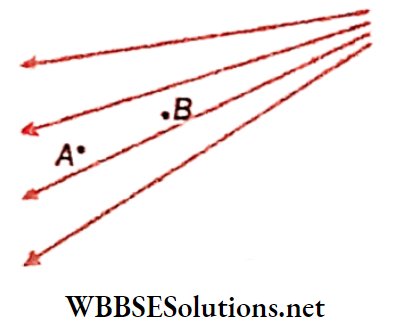
Answer:
In the region of the electric field where the electric lines of force are closely spaced, the electric field is greater. According to the electric field at point B is greater than that at point A. Since the force on the charged particle, F = qE = charge x electric field.
Therefore, the particle will experience greater force at point B.
Question 33. If the area of the cross-section of the cylinder is S, then what will be the electric flux through the cylinder?
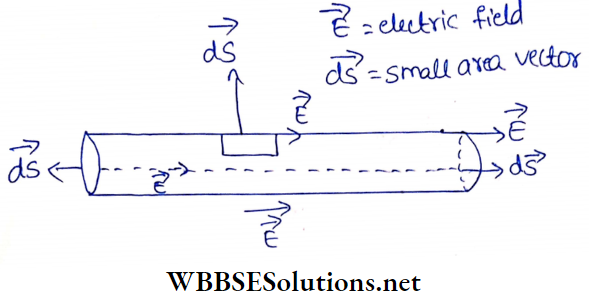
Answer:
Let, the electric flux through the two circular cross-sections of the left side and right side of the cylinder be Φ1 and Φ2 respectively. Φ3 be the electric flux through the curved surface of the cylinder.
As the angle between the normal on the curved surface and \(\vec{E}\) is 90°, so
⇒ \(\phi_3=\int_S E d S \cos \theta\)
⇒ \(=\int_S E d S \cos 90^{\circ}\)
= 0
Now, \(\phi_1=\int_S E d S \cos 180^{\circ}=-E \int_S d S=-E S\)
⇒ \(\phi_2=\int_S E d S \cos 0=+E \int_S d S=+E S\)
∴ \(\text { Net flux }=\phi_1+\phi_2+\phi_3=-E S+E S+0\)
= 0

